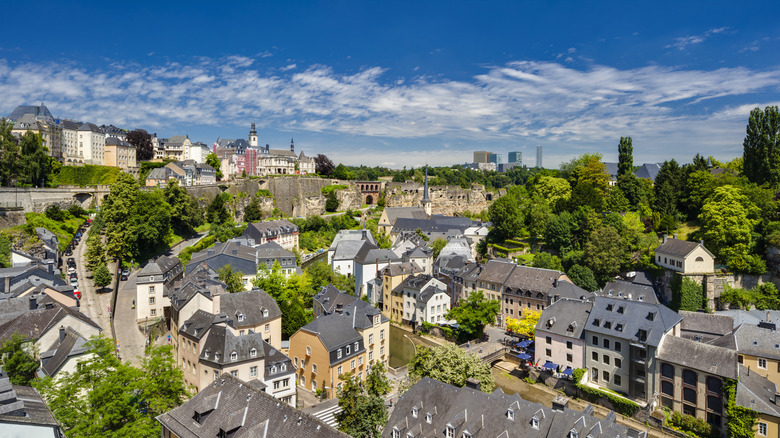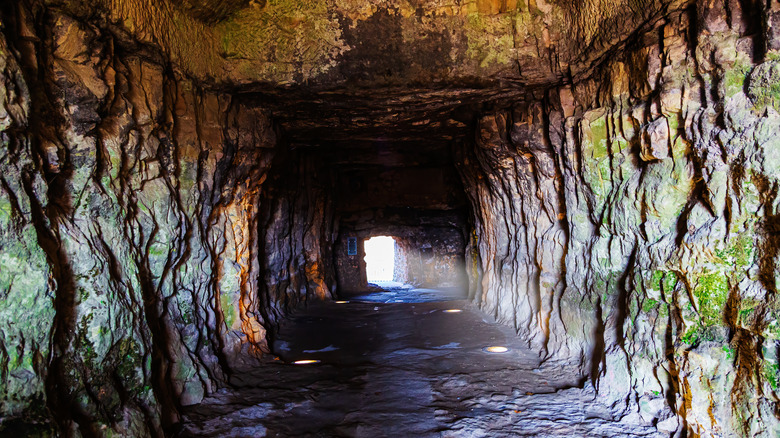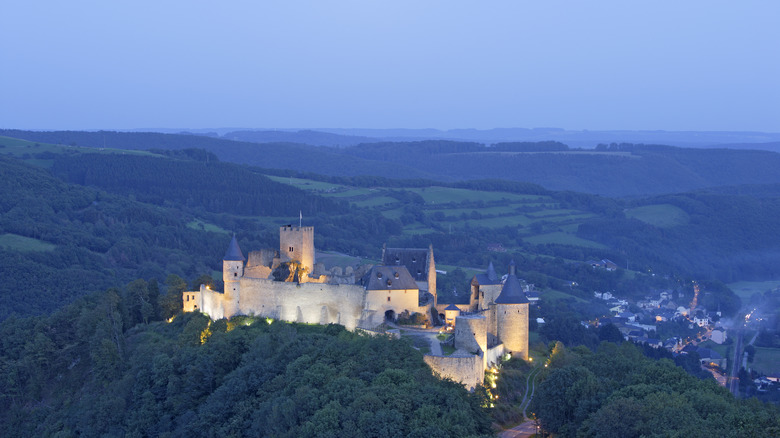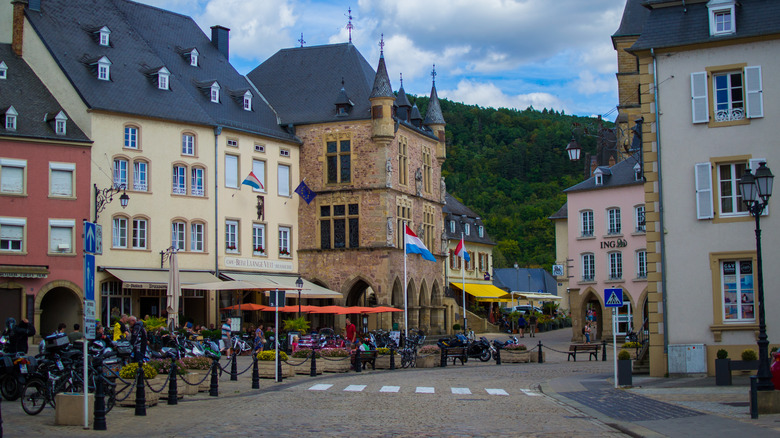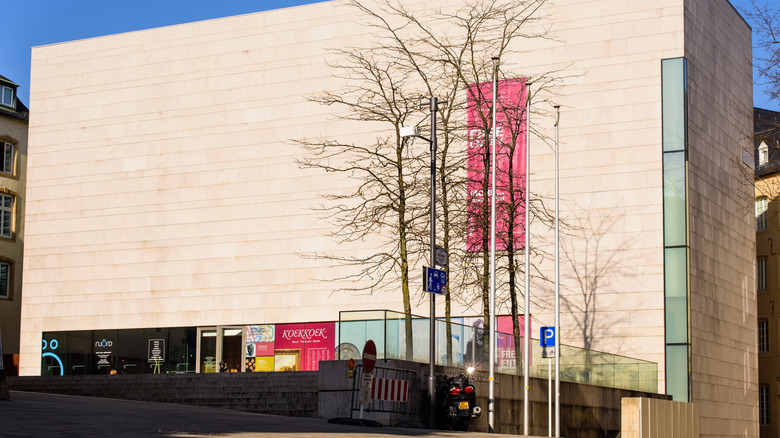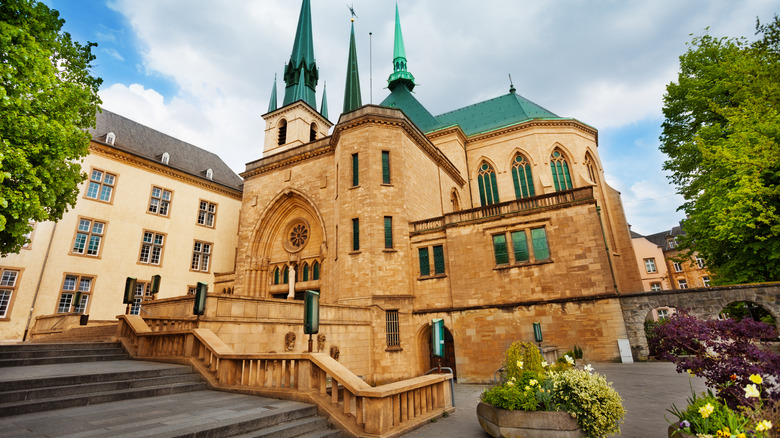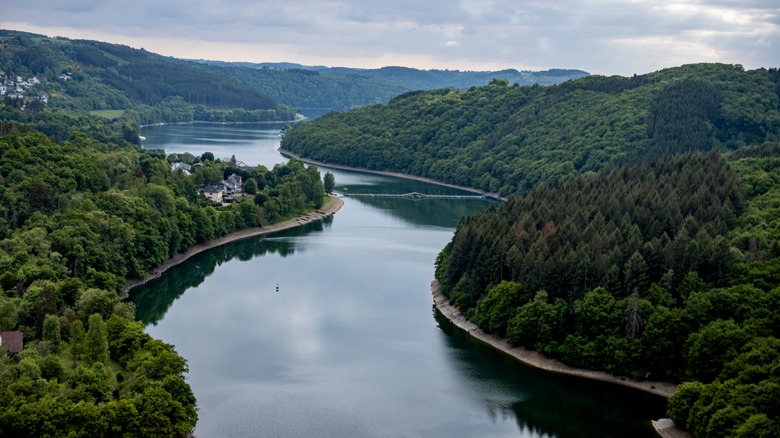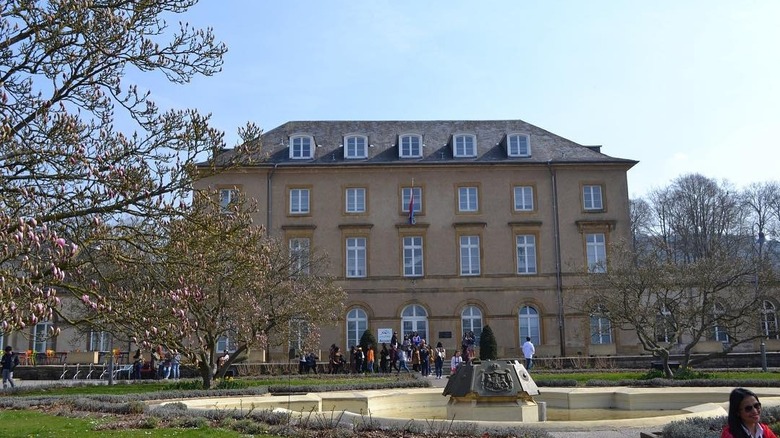12 Of Luxembourg's Most Popular Tourist Attractions
Most travelers to Europe have hot spots like France and Germany on their bucket lists, but smack in the middle of those two popular destinations is one very undervalued one — Luxembourg. Barely the size of Rhode Island, it's jam-packed with history, culture, nature, and charm. Plus, it's among the top destinations in Europe for people who hate crowds. Due to its small size and underrated status, it's easy to see the highlights of Luxembourg in just a weekend. You can get from one end of Luxembourg to the other in under an hour and a half. Public transportation is free in Luxembourg, despite it being an incredibly wealthy country with one of the highest GDPs per capita in the world. To top it off, it is also ranked among the happiest countries in the world.
If you're ready to travel off the beaten path and head to a country that many people don't even dream of seeing, then book your ticket to Luxembourg and get ready to experience both medieval history and Mother Nature's beauty in this traveler-approved laidback destination. We rounded up the country's top landmarks so you don't miss a thing in this small-but-mighty destination, ranging from a 70-mile trail known as one of the best on the continent to what's famously been called "the most beautiful balcony in Europe."
Bock Casemates, Luxembourg City
There's just as much to see below Luxembourg City as there is above ground. The Bock Casemates are ancient bomb-proof military chambers that are now a UNESCO World Heritage Site. Spanning 14 miles, this network of underground tunnels dates back to 1644. In the centuries since, they were used by the Austrians and Prussians as a fortress during wartime. Meander through stone caves that were once used as shelters, storage, command centers, artillery stations, and more, some with windows overlooking the countryside. Even horses once walked these paths. Visitors can expect to see everything from cannons used during the 1800s by the Prussians to original inscriptions on the walls, such as, "Don't forget the sand" — sand was used in the tunnels to help with sanitation.
"What a unique and interesting historical place in the center of Luxembourg City," one past visitor wrote on Tripadvisor. "Our whole family enjoyed our time there, and our kids enjoyed looking out of the openings in the walls. This is a must-see place in Luxembourg." Those interested in checking out this otherworldly underground epicenter can do so by booking 45-minute tours from February through November. Keep in mind that low lighting and rocky terrain make this site more challenging to explore, and those with accessibility needs are asked to call ahead to ensure that they can be accommodated.
Bourscheid Castle, Bourscheid
If you're going to see just one castle in Luxembourg, make it Bourscheid Castle. At more than 129,000 square feet, is the biggest castle in the country as well as one of the most significant. Located in Bourscheid in the Sûre River Valley, the Romanesque-Gothic castle's construction began in the year 1000 and was expanded and reconstructed in later centuries. It eventually culminated in nearly a dozen towers in the 1400s, which all offer panoramic views at more than 500 feet above sea level.
The castle is open to visitors every day of the year for a small fee, no reservation required. People can also make the castle feel like their own for a few hours, as private rentals of the courtyard, Gothic cellar, and other areas are available for special events. Now a designated historic monument, Bourscheid Castle was once the home of the Lords of Bourscheid as well as the Metternich noble family. Today, it still features elements that the families once used, like a drawbridge, terrace, dungeon, kitchen, drawing room, and dining room. "Excellent castle ruins with many places good for pictures," wrote one past visitor on Tripadvisor. "Very fun to let your imagination run wild."
Chemin de la Corniche, Luxembourg City
The Alzette Valley of Luxembourg is a picture-perfect place, and there's no better way to see it than walking what's often referred to as "the most beautiful balcony in Europe." Chemin de la Corniche, which translates to "Cliff Path" in French, sits high above Luxembourg's old 17th-century ramparts with distinctive views of the Alzette River, the Grund neighborhood, and the Rham Plateau.
Traverse this nearly 2,000-foot stone pathway built by the Spanish and French to see legendary sites like Saint Michael's Church, the Bock Bridge, and the Neimënster Abbey. Board the glass-enclosed lift free of charge for panoramic city views and a smooth ride to the Pfaffenthal historic quarter at the base of the Alzette Valley. "The most spectacular place of this lovely city," wrote one past visitor on Tripadvisor. "Whether from the high view at your starting point or for a quiet walk along the way, the views are spectacular and definitely worth it."
Echternach
Luxembourg is packed full of history no matter which way you turn, and in no place is this history richer than Echternach, the oldest town in the country. Its medieval past can be seen from every corner of this small town, from an abbey dating back to the 7th century to a Roman architectural site from the 1st century. Begin your foray into this old-world destination just 40 minutes from Luxembourg City at the Abbey of Echternach, which is one of the most important ancient sites in Luxembourg. It also houses the renowned Echternach scriptorium.
Then, check out the neighboring Basilica of Saint Willibrord, a majestic church where the annual Echternach Dancing Procession takes place. Every June, visitors and locals gather to dance to polka music and visit Saint Willibrord's tomb. Recognized in UNESCO's Intangible World Cultural Heritage, this event is just one of the reasons why Echternach has been named a "European destination of excellence" by the European Commission.
As you meander through town, especially in the Market Square, you'll stumble upon restaurants and shops housed in storied buildings. Look out for the Gothic-style town hall that dates back to the 1300s. The oldest spot in town — as well as the most significant Roman site in the country — is the Roman Villa of Echternach. Here, visitors can see the villa's original base and floors that were built nearly 2,000 years ago.
Grand Ducal Palace, Luxembourg City
Since Luxembourg is the only country in the world with a Grand Duke, the Grand Ducal Place is the only place of its kind. The palace is where Grand Duke Henri, the current Head of State of the Grand Duchy, has been serving Luxembourg for 25 years. Vsitors can get an inside look at the palace if they time their visit correctly. Seventy-five minute guided tours of this opulent Flemish renaissance building are only offered in July and August. If tourists are lucky enough to score a ticket, they'll be able to revel in the spoils that the Grand Duke enjoys, like a grand marble staircase, artwork, banquet hall, and even his private office.
Since the 1500s, the Grand Ducal Palace has been an epicenter of Luxembourg City. After its stone walls were built, it has been the city hall, a beer and concert hall, and the home of Luxembourg's dukes and duchesses. "The decor and the light that streamed in all the huge windows were the perfect backdrop to all the amazing artworks and furnishings that are in every room," wrote one past visitor on Tripadvisor. "They have done an excellent job of preserving their heritage and it was a welcome addition to our itinerary."
Larochette
Another charming small town with a medieval past that's worth exploring is Larochette, only a 30-minute drive from Luxembourg City. With just a few hundred residents, it's an enchanting destination that dates back to the 12th century, and its history is evident everywhere you look. Renowned French poet Victor Hugo loved Larochette so much that he had his own room at a local hotel. Nestled in a valley on the banks of a river, it's no surprise that Larochette inspires creativity.
The winding cobblestone streets are perfect for leisurely strolls, but two places you have to see in Larochette are its two castles. The most significant castle here is the neoclassical style Meysembourg Castle, which is located along the Mullerthal Trail and can be best seen at the Mazenbach viewpoint. It's otherwise not accessible to visitors. On the other side of town, check out Larochette Castle, which, like Meysembourg Castle, dates back to the 12th century. Surrounding Larochette Castle's ruins is a picturesque flower garden and a café, and the castle itself is occasionally open for concerts and art exhibitions.
Back in the main part of town and near the medieval square, Larochette has a few other buildings worth looking out for. Check out the Textile Museum in the Larochette Railway Station, as well as the Manor of Roebé, a relic of the grand bourgeoisie period. The latter is one of the oldest buildings in Larochette, constructed in the 18th century.
Mullerthal Trail
Not only is Luxembourg's medieval history underestimated, but so is its natural beauty. The country is home to the Mullerthal Trail, a 70-mile trail network on the Germany-Luxembourg border that's often called one of the best hikes on the continent. Dubbed "Little Switzerland," the three trails in this network take hikers through lush forests, towering rock formations, castle remnants, and ancient villages. It's one of the best ways to see the country on foot, all without the typical crowds of popular tourist destinations. Visit in the early spring and fall for even fewer crowds and refreshing weather. You can explore the Mullerthal Trail on your own or with a guide.
Three loops make up the Mullerthal Trail, ranging from intermediate to difficult. The trails start in Echternach, Berdorf, and Beaufort. Several other connecting hikes are also located on the trail, making it easy to extend your excursion and choose your own adventure. Plus, the free public transportation and abundance of campsites make this an affordable activity for visitors; a welcome relief for those looking to save money, as Luxembourg also has a reputation for being an expensive place to visit.
"Spectacular!!!!! Many routes to do in this area, with idyllic landscapes among pines and ferns that coexist with spectacular rocks. A natural wonder worth seeing," wrote one past visitor on Tripadvisor.
National Museum of Archaeology, History and Art
An ideal place to start your visit to the underrated and charming Luxembourg City is the National Museum of Archaeology, History and Art. Located in the center of the UNESCO-designated Old Town and spanning nearly 67,000 square feet, this colossal destination goes beyond a typical museum. It envelops visitors in immersive and fascinating exhibits, such as rooms carved into rocks that showcase the museum's archaeological collection. Best of all, the museum's permanent exhibits are free to visit. As you might expect from a country so rich in history, the museum is full of beautifully-preserved artifacts dating back to 240 CE.
"Superb to do with children, from prehistory to modern art, there is something for everyone," reads one review on Tripadvisor. "There is so much to see here it is possible to spend upwards of half a day. Everything is very well curated and presented," says another.
Notre-Dame Cathedral, Luxembourg City
With grand lion statues at the front, stained glass windows, and bronze gates, the Notre-Dame Cathedral is one of the most popular sites in the country with thousands of annual visitors. The church has seen such admiration throughout the years that it was even expanded in the early 1900s. The primarily Gothic-style church in Luxembourg City is also the burial site of notable local figures. These include John the Blind, the King of Bohemia, Count of Luxembourg, and members of the Grand Ducal family. Notre-Dame Cathedral dates back to the early 1600s and is free to visit daily.
The cathedral has undergone major changes throughout the centuries, with many relics from its history still on display today. Visitors can see the wooden Virgin Mary statue on display inside the cathedral, or during the yearly spring procession when it's decorated and paraded in the Octave pilgrimage. Even if you won't be in Luxembourg for the occasion, the procession is often on broadcasted on TV.
"Viewed by day, it impresses with the elegance of the architecture and the care of the interior," one past visitor wrote on Tripadvisor. "Spacious, bright and well maintained, it is an interesting stop in the historic center, even for those who have little time."
Upper Sûre Natural Park
Hiking the Mullerthal Trail isn't the only way to see the stunning natural landscapes that permeate Luxembourg. Lovers of nature can also see it in all its glory at Upper Sûre Natural Park, a nearly 57,000-acre park in northwestern Luxembourg. The must-see highlight of this respite is Upper Sûre Lake, the biggest lake and reservoir in Luxembourg, with plenty of opportunities for swimming, canoeing, kayaking, and more in very clean water.
If you're more of a landlubber, venture through Upper Sûre Natural Park's nearly 200 miles of trails, from which you may see birds like black storks and ospreys. A few of the most popular trails in the park include the Upper Sûre Lake Trail, which surrounds the lake, as well as the Éislek Pied trails. Several bike paths are also located throughout the park.
These trails and bike paths also take visitors on a trip through history. On Schumannseck's Battle of the Bulge Memorial Trail, people can see a life-sized snapshot of the World War II battle with 65 replicas of fighting soldiers alongside information panels and artifacts. The brutal battle left behind bomb craters and foxholes that are still visible on the 2-mile trail today.
Vianden
If you're heading out for a day trip from Luxembourg City, there's a good chance you're going to Vianden — as you should. This small town that's less than an hour's drive from Luxembourg City is packed with must-see sights, including Vianden Castle, writer Victor Hugo's former home, a scenic chairlift, and more. Vianden was once one of the biggest cities in the country, as well as a cultural epicenter, with the castle as its famous focal point.
The Gothic-Romanesque-style Vianden Castle over the Our Valley dates back to 3rd century, although it saw many iterations throughout its tenure. In the 1980s, it was restored to its former glory, and has since become a popular tourist destination and even a wedding venue. It can be explored on a 90-minute self-guided tour. Towering over the town of Vianden, it's one of the best-preserved castles on the continent.
Also offering sweeping views is the Vianden Chairlift, an excellent opportunity to see the castle and the town's other sights from 1,440 feet. Once you make your way back down, head to the Victor Hugo House Museum, where the famous writer lived, worked, and fought for human rights in the 1800s.
Walferdange Castle, Walferdange
Located in Walferdange, one of the smallest towns in Luxembourg, is the grand Walferdange Castle, one of the country's few castles commissioned by a Grand Duke. It was built in the early 1800s by Grand Duke Willem I of the Netherlands before it was abandoned for a decade. The castle was eventually refurbished by the Duke's son, Grand Duke Willem II, who used it as his home when he visited Luxembourg and hosted his royal guests.
The Duke's family continued to reside there until it was abandoned once again. In the years since, Walferdange Castle has been repurposed many times — it was once a school, army barracks during World War II, U.S. Army headquarters, and a University of Luxembourg building. Finally, as it currently stands, it's the home of the country's Ministry of Education. Surrounding the building are monuments that pay tribute to various periods of Luxembourg history.
Methodology
We at PlanetWare made it easier for you to plan your Luxembourg getaway by rounding up the best tourist attractions in the country. To do so, we evaluated recommendations from local tourism boards as well as highly-rated destinations by verified users on review platforms such as Tripadvisor and Google Reviews. We also determined which spots are the most renowned in their respective categories. For exmple, Upper Sûre Natural Park is home to the largest lake in the country, and Bourscheid Castle is Luxembourg's largest castle. Finally, we highlighted places that capture what makes Luxembourg truly one of a kind, with the Grand Ducal Palace serving as a prime example.
With 195 countries on the planet, it's easy to forget about little Luxembourg. However, those that bypass this European hidden gem are missing out. With everything from natural beauty to age-old history, you'll quickly find your itinerary overflowing with things to do, yet these are the places that deserve a top spot on your list.
